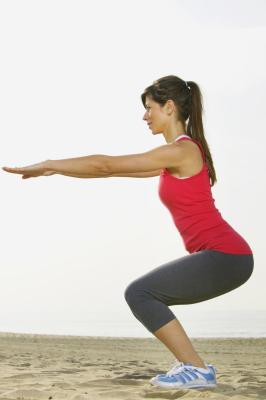
Article was originally published in Chron Live Healthy.com
Republished on Week& HEALTHY LIVING|FITNESS
A squat is a compound, whole-body exercise that targets the muscles in your lower body and back. If performed correctly, squats help prevent injuries, enhance sports performance, promote mobility, improve balance and strengthen bones that are at risk of weakening due to osteoporosis. By adding hand weights, you can increase the load on your bones and muscles to better improve strength.
Chair Squats
Squats can be hard on your lower back and knees if you haven’t developed proper strength and flexibility. To prepare your body for full squats, begin with chair squats. Stand with your toes and knees facing forward and the backs of your calves against a stable chair. This will teach you how to properly pivot at your ankles, knees and hips. Push your hips back as if you were going to sit down on the chair. With your back straight, tip your torso forward and reach your arms in front of you as your hips move back. Without moving your knees forward, pivot at your knees and hips and slowly lower your bottom toward the chair. Your weight should shift over your heels. Then, brace your abdominals, keep your calves touching the chair, swing your arms down by your sides and shift your hips forward to straighten your legs so you are standing upright.
Full Squats
Once you can easily squat without moving your calves from the chair, advance to a full squat. Start with your legs in a wide stance and your toes and knees facing forward. Squatting with your feet greater than hip-width distance apart will increase balance during the squat, place less stress on your knees and improve hip strength. Repeat the movement that you did for the chair squat, reaching your hands in front of you and looking straight ahead as you squat. Don’t try to go too low at first. As you get stronger, you will be able to lower your hips so they are at the same level as your knees and your thighs are parallel to the floor. Do not go any lower than this. When you can consistently perform the squat with a wide stance, vary the position of your legs, bringing them close together for some repetitions and farther apart for some.
Add Hand Weights
Adding hand weights increases the intensity of your squats. Loosely grasp a set of hand weights by your sides. Start with two to five pounds and increase the weight size as you get stronger. Do one set of eight to ten squats with your arms hanging by your sides. You can add a variety of arm exercises to your squats for a full body workout. Good choices for hand weight exercises with squats include upright rows, bicep curls, triceps kickbacks, lateral raises and front raises.
Safety During Squats
To prevent injury, avoid arching your back during a squat, don’t allow your knees to extend forward past your toes; pivot your ankles, knees and hips as you squat. If you have a prior injury, are pregnant or have other health considerations, consult a physician, physical therapist or personal trainer before adding squats with hand weights to your routine.
References
About The Author
|Updated
This article was originally published in Chron Live Healthy.com
Republished on Week& HEALTHY LIVING|FITNESS



